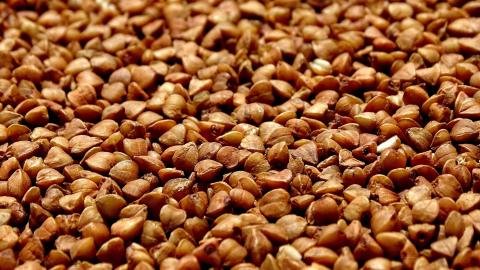Get healthy with Himalayan Tartary Buckwheat: Discover the many health benefits of this superfood

Himalayan Tartary Buckwheat is a gluten-free, nutrient-rich superfood that has been gaining popularity in recent years due to its many health benefits. This ancient grain is native to the Himalayan region and has been a staple food for centuries. It is a good source of protein, fiber, and minerals, and contains powerful antioxidants that can help protect against disease.
Himalayan Tartary Buckwheat is a rich source of protein, containing all nine essential amino acids. It is also high in fiber, which can help improve digestion and promote feelings of fullness. In addition, it contains a variety of minerals, including magnesium, potassium, and zinc, which are essential for overall health.
Research has shown that Himalayan Tartary Buckwheat contains powerful antioxidants that can help protect against disease. These antioxidants include quercetin, rutin, and luteolin, which have been shown to have anti-inflammatory and immune-boosting properties. In addition, Himalayan Tartary Buckwheat may help improve brain function, lower cholesterol levels, and regulate blood sugar levels.
Ready to Learn More?
Check out COLSA's research into this topic and read about other COLSA research!Tartary Buckwheat: A Climate-Ready Crop for the FutureCOLSA's Research DirectoryNH Agricultural Experiment Station Research Areas
Key Takeaways
- Himalayan Tartary Buckwheat is a gluten-free, nutrient-rich superfood that is a good source of protein, fiber, and minerals.
- It contains powerful antioxidants that can help protect against disease and has been shown to have anti-inflammatory and immune-boosting properties.
- Himalayan Tartary Buckwheat may help improve brain function, lower cholesterol levels, and regulate blood sugar levels.
Research at the University of New Hampshire, led by New Hampshire Agricultural Experiment Station scientist Iago Hale, is exploring Tartary buckwheat as a sustainable option for crop farmers in the Northeast United States. Hale's newly established Tartary buckwheat breeding and genetics program focuses on this crop's resilience to climate change and its ability to thrive in Northern New England's variable weather, offering a nutritious and environmentally suitable alternative for local agriculture.
Related Posts:
Nutritional Profile of Himalayan Tartary Buckwheat

Protein Content
Himalayan Tartary Buckwheat is a rich source of protein, containing about 13.3 grams of protein per 100 grams of boiled groats. Buckwheat protein extract has been found to be more efficient in lowering blood cholesterol levels compared to soy protein and casein. Sulfur-containing amino acids, glycine, arginine, and lysine present in buckwheat protein are believed to play a crucial role in lowering cholesterol levels.
Fiber Content
Buckwheat is high in dietary fiber and resistant starch, which helps in maintaining colon health and has beneficial effects on glucose metabolism. The metabolites formed during fermentation of resistant starch and other indigestible carbohydrates in the large intestine contribute to the suppression of body fat, constipation, mammary carcinogenesis, and colon carcinogenesis in rats, and in the formation of cholesterol gallstones in hamsters.
Mineral Composition
Himalayan Tartary Buckwheat is a good source of minerals such as magnesium, iron, and selenium. These minerals play a complementary role in the therapeutic effects of buckwheat.
Vitamin Content
Buckwheat is a good source of vitamins such as vitamin B6 and vitamin B1. These vitamins play a crucial role in the proper functioning of the body.
Antioxidant Capacity
Himalayan Tartary Buckwheat is a rich source of flavonoids such as rutin, which has been found to reduce blood cholesterol levels, keep capillaries and arteries strong and flexible, improve blood microcirculation, and protect blood vessels from rupturing and forming clots. These flavonoids also demonstrate antioxidant, antimicrobial, and anti-inflammatory activities.
Related Posts:
Health Benefits
Himalayan Tartary Buckwheat (HTB) is a superfood that is packed with various nutrients, vitamins, and minerals that provide numerous health benefits. Here are some of the most notable health benefits of HTB:
Cardiovascular Benefits
HTB is rich in flavonoids such as rutin, quercetin, and luteolin, which are known for their antioxidant and anti-inflammatory properties. These flavonoids help in reducing the risk of heart diseases by preventing the oxidation of LDL cholesterol and reducing inflammation in the arteries.
Digestive Benefits
HTB is an excellent source of dietary fiber, which is essential for maintaining good digestive health. The fiber in HTB helps in promoting regular bowel movements, preventing constipation, and reducing the risk of colon cancer.
Weight Management Benefits
HTB is low in calories and fat, making it an ideal food for people who are trying to lose weight. The fiber in HTB also helps in keeping you full for longer, reducing your appetite, and preventing overeating.
Blood Sugar Regulation
HTB is a good source of magnesium, which is essential for regulating blood sugar levels. Magnesium helps in increasing insulin sensitivity, which allows the body to use glucose more effectively and reduces the risk of developing type 2 diabetes.
Anti-Inflammatory Benefits
HTB is rich in antioxidants such as quercetin, which help in reducing inflammation in the body. Chronic inflammation is linked to various health problems such as heart diseases, diabetes, and cancer. By reducing inflammation, HTB helps in reducing the risk of these diseases.
Related Posts:
Iago Hale, an associate professor of agriculture, nutrition and food systems at the University of New Hampshire's College of Life Sciences and Agriculture, recently launched a Himalayan Tartary Buckwheat breeding and growing program. His work emphasizes not only the crop's nutritional benefits but also its adaptability to the Northeast's variable climate conditions. A primary goal of this research program, which will build upon the USDA's knowledge of growing and harvesting Tartary buckwheat, is to support regional agricultural sustainability.
